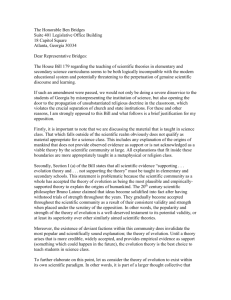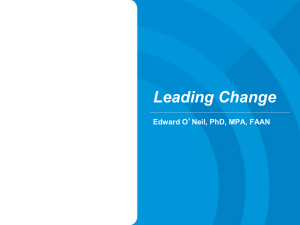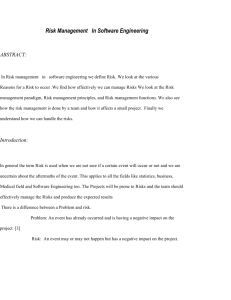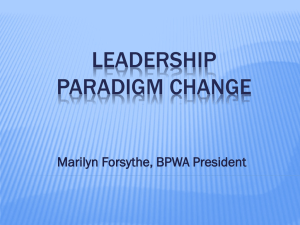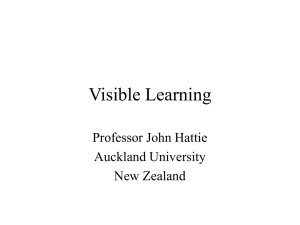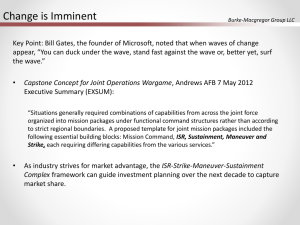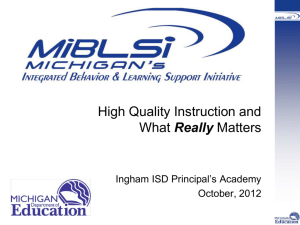*The illiterate of the 21st century will not be those who cannot read
advertisement
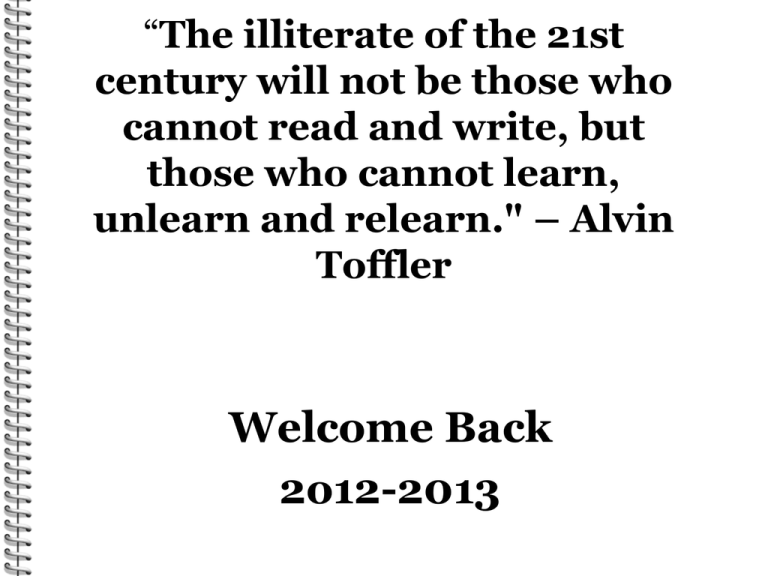
“The illiterate of the 21st century will not be those who cannot read and write, but those who cannot learn, unlearn and relearn." – Alvin Toffler Welcome Back 2o12-2013 John Hattie on the art of teaching “…the act of teaching reaches its epitome of success after the lesson has been structured, after the content has been delivered, and after the classroom has been organised. The art of teaching, and its major successes, relate to “what happens next” – the manner in which the teacher reacts to how the student interprets, accommodates, rejects and/or reinvents the content and skills, how the student relates and applies the content to other tasks, and how the student reacts in light of success and failure apropos the content and methods that the teacher taught. Learning is spontaneous, individualistic, and often earned through effort. It is a timeworn, slow, gradual, fits-and-starts kind of process, which can have a flow of its own, but requires passion, patience, and attention to detail (from the teacher and the student)”. Learning is……………. Paradigm Shift: Teaching to Learning I taught Spot how to whistle. I can’t hear him whistling. I said I taught him. I didn’t say he learned it! Paradigm Shift • Old – Instruction Paradigm –An educational institution exists to provide instruction. • New – Learning Paradigm –An educational institution exists to produce learning. What is the difference? ProvideProduce Teaching Paradigm Telling students what they need to know… Learning Paradigm Engaging students in learning how to learn… Our Core Business To produce work that engages students work that is so compelling that students persist when they experience difficulties, and that is so challenging that they have a sense of accomplishment and satisfaction indeed, of delight - when they successfully accomplish the tasks assigned. Role of Teacher OLD NEW Teacher as disciplinary experts who impart knowledge through lecture Teacher as Designers of learning environments applying best teaching methods Coach interacting with a team Actor on stage Delivering a lecture Designing and playing a team game Role of the Student • Moves from the role of note taker (passive) to active participant in the learning process • Allows students to take control over their learning and, therefore, forces them to take more responsibility in the classroom Benefits of Student-Centered Learning 1. 2. 3. 4. 5. 6. 7. Permits opportunities to connect the content to real life Provides opportunities for higher order thinking as opposed to passive listening Promotes greater student-teacher and student-student interaction Increases student retention Provides for improvement of social interaction skills, greater acceptance of others, and a greater sense of “community” in the class Encourages alternative forms of assessment Encourages innovation in both teaching and student involvement Challenges to Implementing a Paradigm Shift 1. Lack of confidence in trying new methods 2. Fear loss of content coverage 3. Loss of control over the class 4. Lack of prepared materials for use in the class 5. Lack of background or training in the use of active learning approaches I taught Spot how to whistle. I can’t hear him whistling. I said I taught him. I didn’t say he learned it! Providing or Producing? Influences on student learning John Hattie 1999-2009 – research from 180,000 studies covering almost every method of innovation • • • • • • • • • Effect Size Feedback 0.73 Teacher-Student Relationships 0.72 Mastery Learning 0.58 Challenge of Goals 0.56 Peer Tutoring 0.55 Expectations 0.43 Homework 0.29 Aims & Policies of the School 0.24 Ability Grouping 0.12 If feedback is so important, what kind of feedback should be taking place in our classrooms? “The most powerful single influence enhancing achievement is feedback” • Quality feedback is needed, not more feedback • Much of the feedback provided by the teacher to the student is not valued and not acted on • Students with a Growth Mindset welcome feedback and are more likely to use it to improve their performance • Oral feedback is much more effective than written • The most powerful feedback is provided from the student to the teacher Teacher – Student Relationships • Developing a warmer socio-emotional climate in the classroom, fostering effort and thus engagement for all students, requires teachers to enter the classroom with certain conceptions about progress, relationships and students. • It requires them to believe that their role is that of a change agent – that all students can learn and progress, that achievement for all is changeable and not fixed, and that demonstrating to all students that they care about their learning is both powerful and effective. Visible Learning P.128, The Contributions from the Teacher – J.Hattie 2009 Mastery Learning: All children can learn when they focus on mastering tasks in a collaborative environment. Appropriate learning conditions in the classroom include: High levels of cooperation between classmates; Focused teacher feedback that is both frequent and diagnostic; Variable time allowed to reach levels of attainment Setting Goals • There is strong evidence that challenging, achievable goals influence achievement, provided the individual is involved in setting them. • Locke & Latham (1990) found that achievement is enhanced to the degree that teachers set challenging, rather than “do your best” goals, relative to the students’ present competencies. There is a direct linear relationship between the degree of goal difficulty and performance . • Goals have a self-energizing effect if they are appropriately challenging as they can motivate students to exert effort in line with the difficulty or demands of the goal. • Commitment to the goals helps, but is not necessary for goal attainment – except for Special Needs students, where commitment makes a major difference. Setting Goals – Personal Bests • Martin (2006) argued that a good method to assist students in setting task-specific and situation-specific goals was to use the notion of “personal bests”. • He found that setting personal bests had high positive relationships to educational aspirations, enjoyment of school, participation in class and persistence on the task. • In a study by Russell Bishop students, parents, management and teachers were asked what are the major influences on student achievement. • WHAT DO YOU THINK EACH ANSWERED? ANSWERS • All except the teachers said the relationships between the teachers and the students!!!! • Teachers thought: • Child’s attitude and disposition • Child’s home background • Working conditions of the school • OR that pupils who are not learning are deficient in some way. • How can we combat this attitude in ourselves?

